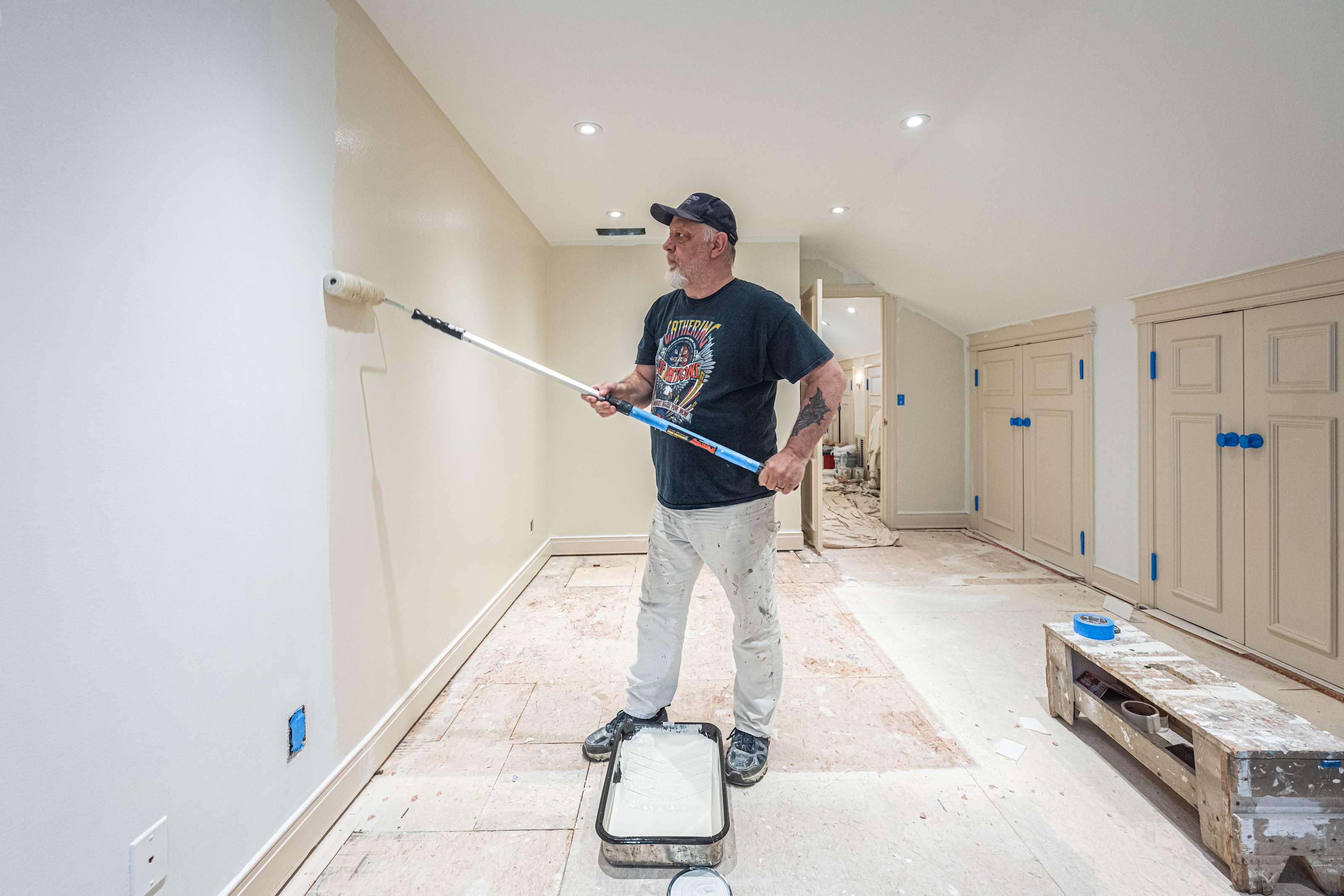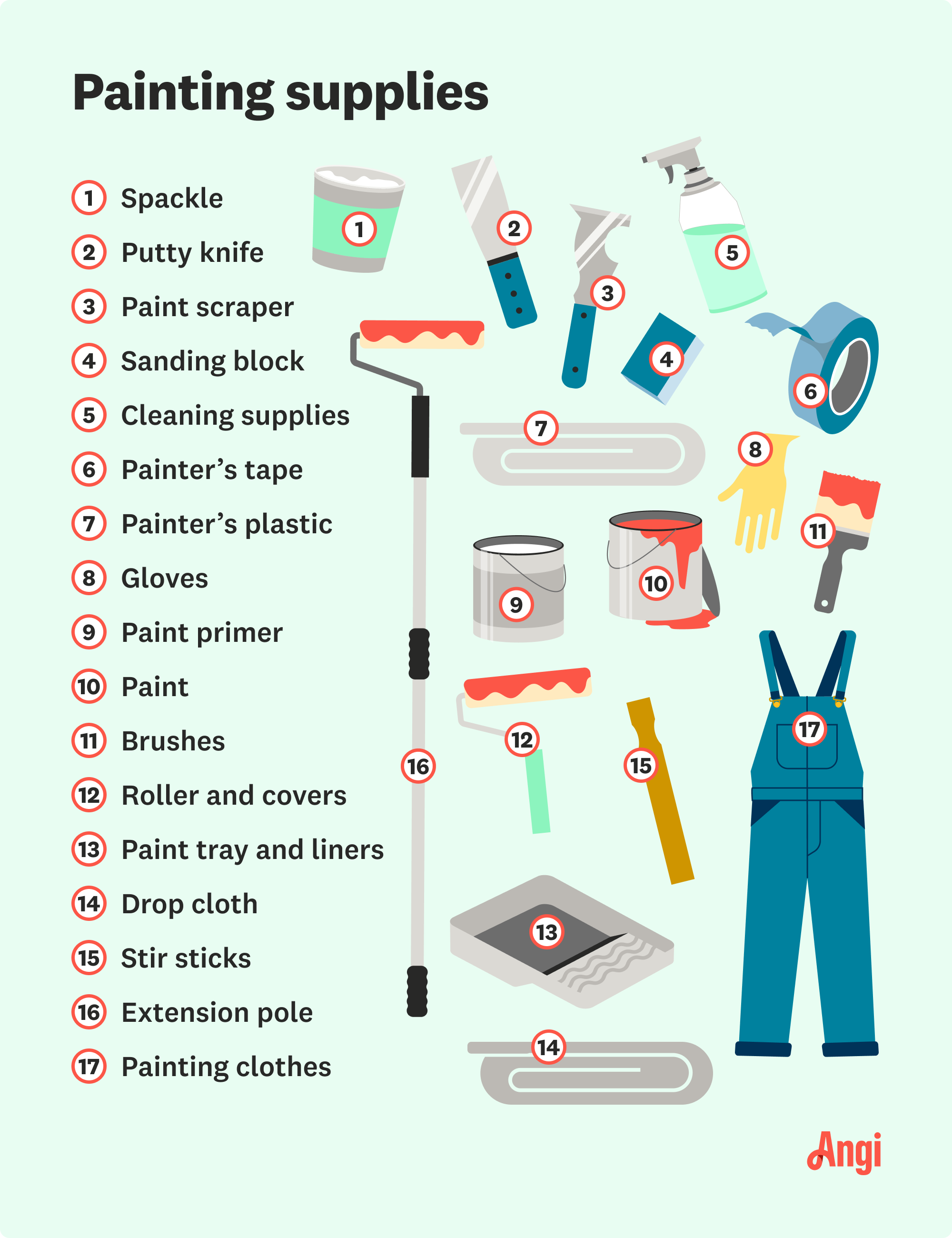
How much does it cost to paint a room? Learn what you’ll pay to give your space a makeover, depending on room size, paint type, the pro you hire, and more.
Step up your DIY painting skills


Learning how to paint stair railings adds a whole new and useful element to your DIY bag of tricks. While the process follows similar steps as any interior painting job, there are some extra details to consider to really nail the task. Painting your stair railing like a pro requires choosing the best materials for the job and a bit of patience.
Oil-based paints contain higher volatile organic compounds (VOCs) than latex paints. To limit your exposure to VOCs while painting indoors, keep the area well-ventilated, wear respiratory protection, and avoid the painted area for at least 72 hours once finished.

In addition to following solid home painting tips, pairing the task of painting your stair rails with choosing the best materials for the job is a must. Because stair railings must deal with heavy traffic that differs from your walls, completing the job with high-quality primer, paint, and poly finish will help ensure your work lasts.
Start by choosing a stain-blocking primer to help the paint stick. Match oil-based or latex-based primers to oil or latex-based paints. While oil paints have a reputation for durability, modern latex enamels come close to matching it, so choosing oil or latex is a matter of personal choice. However, latex dries faster and is recoatable sooner, which can reduce the project's time requirement.
The best paint for railings is enamel in satin, semi-gloss, or gloss varieties. Avoid low-sheen and flat-finish paints as they aren't as durable and tend to trap dirt more than shiny versions.
If your railing painting project is part of a larger painting job, choose between painting the walls or the handrail and trim first. Additionally, protect or remove any wallpaper borders or wallpaper that will be near your work. If you need to protect the wall where the railing meets it, use small pieces of painter's tape.
Also, be sure to protect the floor and stair surfaces with a drop cloth or plastic. However, be very aware of ladder safety if you're using one to paint part of the railing or balusters. Refrain from placing a ladder on top of a drop cloth or plastic sheet over a solid floor surface.

Get into action by thoroughly cleaning the railing and baluster surfaces. Use a degreaser to eliminate the dirt and grime from every surface. Be sure to get into the small spaces where your sandpaper will have a tough time reaching.
Using a combination of a 220-grit sanding block and 220-grit sandpaper, lightly sand every surface of the stair railing system that you'll paint. Don’t rub too hard or for too long—you're just trying to scuff the surfaces to allow the primer to stick. Use a damp cloth to wipe away the sanding dust left behind. Let it dry.
Because of the use that your railing is subject to, applying primer, even on already-painted railings, is essential. Paint primer not only covers the old finish, but also provides a paint-friendly and sticky surface for your finish to adhere to. Apply the primer with a wide brush where you can and use a smaller, or artist's, brush to cut in the details and where the railing meets the wall or stair step surfaces.

Much like painting walls and ceilings, the order and process you use to paint your stair railing is essential. Apply your first coat of paint using a combination of a wide brush, a thin brush, and artist's brushes where each is appropriate. Tiny artist's brushes are excellent for getting to the bottom of tight grooves in the railing or balusters without making a mess.
Work in sections to avoid missing spots, and work from one side to the other to make things easy. If you're right-handed, work from left to right to help keep from touching wet paint. Go the other way if you're left-handed.
Your stair railing will require at least two coats of paint for beauty and durability. Allow the first coat to dry completely and repeat the painting step in the same way as the first.

While not absolutely necessary, adding a polyurethane finish over your painting job will enhance its beauty and increase its durability. If you use a high-gloss paint, very lightly scuff the paint's surface with your sandpaper before applying the poly. For all other sheen choices, apply the poly in the same manner as a coat of paint. Consider applying a second coat for high-use railings or on the handrail portions where heavy use is the norm.
When it comes to tackling a painting project, choosing the right color is key. According to Angi homeowners who are completing a small painting project, 37% stick with the same or a similar color to the existing one. Of those looking to choose something different, nearly 30% opt for a lighter color compared to 18% choosing a darker shade. So, if you’re looking to paint a stair railing, it may be worthwhile to stick with a similar or lighter shade to what’s currently in the room.
Painting your stair railing is an excellent way to up your DIY game and save money. However, because the task can be tedious, many homeowners choose to hire a local interior painter for the job. The cost of professional interior painting is between $1 and $6 per linear foot for trim and railings. Choosing between hiring it out and doing it yourself is often a matter of your budget and how much having your weekend free to do more enjoyable things is worth to you.
I got interior painting done and I couldnâ t be happier!! The team did a professional job and their quality of work is outstanding. I did not have any issues and highly recommend.
Always on time, very knowledgeable about his craft,cleans up after themselves, reasonable pricing. Would highly recommend them to paint my house again.
Amazing customer service. They were patient and helpful and really got the job done right. Interior painting job came out beautifully. Work quality is exemplary and I would recommend them if you are looking for great quality and great prices.
Gustavo and First Call Contractors are outstanding! Over the past year, my family has worked with First Call Contractors on a variety of projects - bedroom renovations, interior painting, bathroom repair, carpentry, and more. We appreciate the team's high quality of work, transparency, and...
A very good company to work with: professional, reasonably priced, and willing to go above and beyond to satisfy the customer. We had rotted wood and new aluminum roof trim installed, and the result is perfect and done on time. I definitely recommend them and will certainly use them for...
The service was excellent! Norwin's trap caught the dangerous bob cat in short order. I am very thankful!
Brandon Burnette did such a great job. I'm so happy I had him as my worker today. Very nice and friendly young man. 10 star in my book.
We had Brandon from DeMarks come out and power wash our siding. The house is 26 years old and had never been washed before. I can not say enough about how hard he worked to get every inch of the house sparkling clean. Not only did he wash the siding, but the soffit, fascia, and gutters as...
We had LHR install a new roof and gutter system. While they were not the cheapest, they were considered the most reliable and fetish for using only high-value products that would last for many years. Additionally, they were highly professional and never tried to push their services or any...
Encore Painting did a fantastic interior paint job for two of our offices. Very professional, clean and efficient paint crew. Communication was great and I would highly recommend.
From average costs to expert advice, get all the answers you need to get your job done.

How much does it cost to paint a room? Learn what you’ll pay to give your space a makeover, depending on room size, paint type, the pro you hire, and more.

The cost to paint the interior of a house in Columbus, OH depends on size, layout, type of surface, and more. Learn what factors can influence your total in this guide.

The cost to paint the interior of a house in Atlanta, GA depends on size, layout, type of surface, and more. Learn what factors can influence your total in this guide.

Learn the benefits and drawbacks of the types of paint finishes and which option works best for different surfaces in your home.

Need to remove old, chipping, or flaking paint before refreshing? Learn about paint removal costs in this guide to see how much you should budget.

Paint on metal doesn’t have to be permanent. Learn how to remove paint from metal yourself with various household methods.